Pothos Plant Care: The Easiest Trailing Houseplant
Want a hanging houseplant that’s a snap to maintain? Your search ends here. Learn about Pothos plant care and how to keep your trailing beauty growing and healthy.
I started my horticultural career in the interior landscaping trade, where we put thousands of these popular plants into offices, lobbies, hotels, banks, airports, and malls. These lush and versatile plants are known for their beautiful trailing vines.
Pothos are one of the most popular houseplants in the world. Besides being easy to maintain, they’re easy to find, and buying one will barely put a dent in your wallet. You can buy a beautiful trailing Pothos in a 6″ pot with long stems for under $20. Pothos vines will do just that and add a lush tropical vibe to your home.
Lucy, who used to work here, started her houseplant gardening journey with a Golden Pothos. This was the very first houseplant she ever bought, and it thrived. It gave her the confidence to move on to other houseplants. If you’re new to the world of indoor plants, by all means, give this one a go, and you’ll feel your thumbs getting greener!
Botanic name: Epipremnum aureum Common name: Pothos, Devil’s Ivy
Pothos Plant Traits


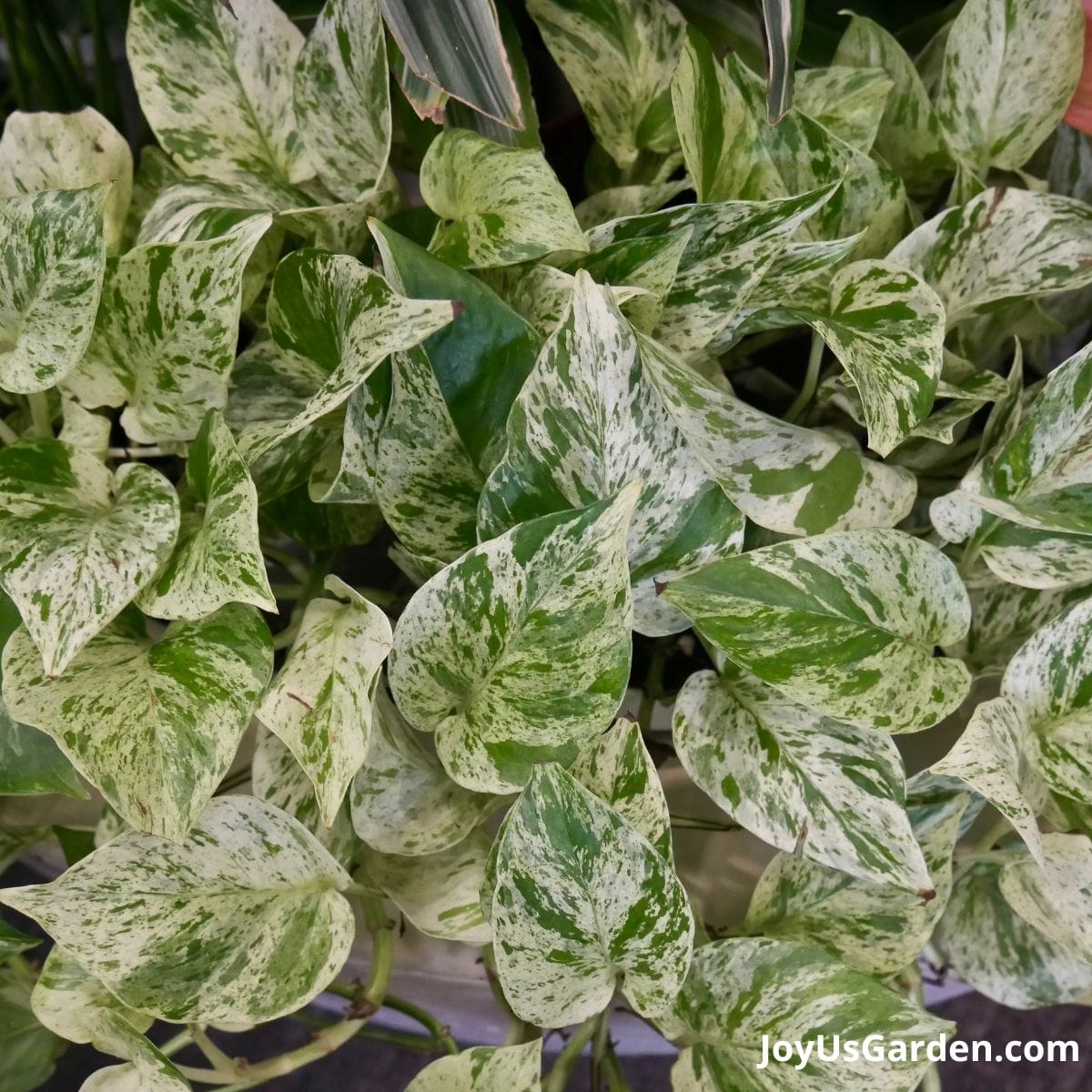
How to Use Pothos
Pothos are trailing plants and are great to use in a hanging basket. I have my Golden Pothos in a ceramic pot (it’s still in the grow pot) that sits atop my bookcase and trails down two sides and across the floor. My Neon Pothos sits on a floating corner shelf behind my ZZ Plant. My Pothos Enjoy grows on a long table with seven other tabletop plants.
Used at the base of a floor plant in a large container, Pothos look good and do well as under plantings. They disguise a grow pot beautifully, so consider them an alternative to moss!
I’ve also seen them growing upright over hoops, on a tall piece of wood or bark, on trellises, attached to walls and moss poles, and in dish gardens and living walls.
Size
You can buy them in 4, 6, 8, and 10″ grow pots. The 6 – 10″ pots often have hangers you can snap off if you wish to remove them. I bought my Marble Queen in a 6″ pot; the trails were about a foot long.
Growth Rate
Pothos are moderate to fast growers indoors, especially in the warmer months. In winter, like your other indoor plants, you won’t see much, if any, growth.
If you have a Pothos plant growing in lower light conditions, the growth rate will be slower.
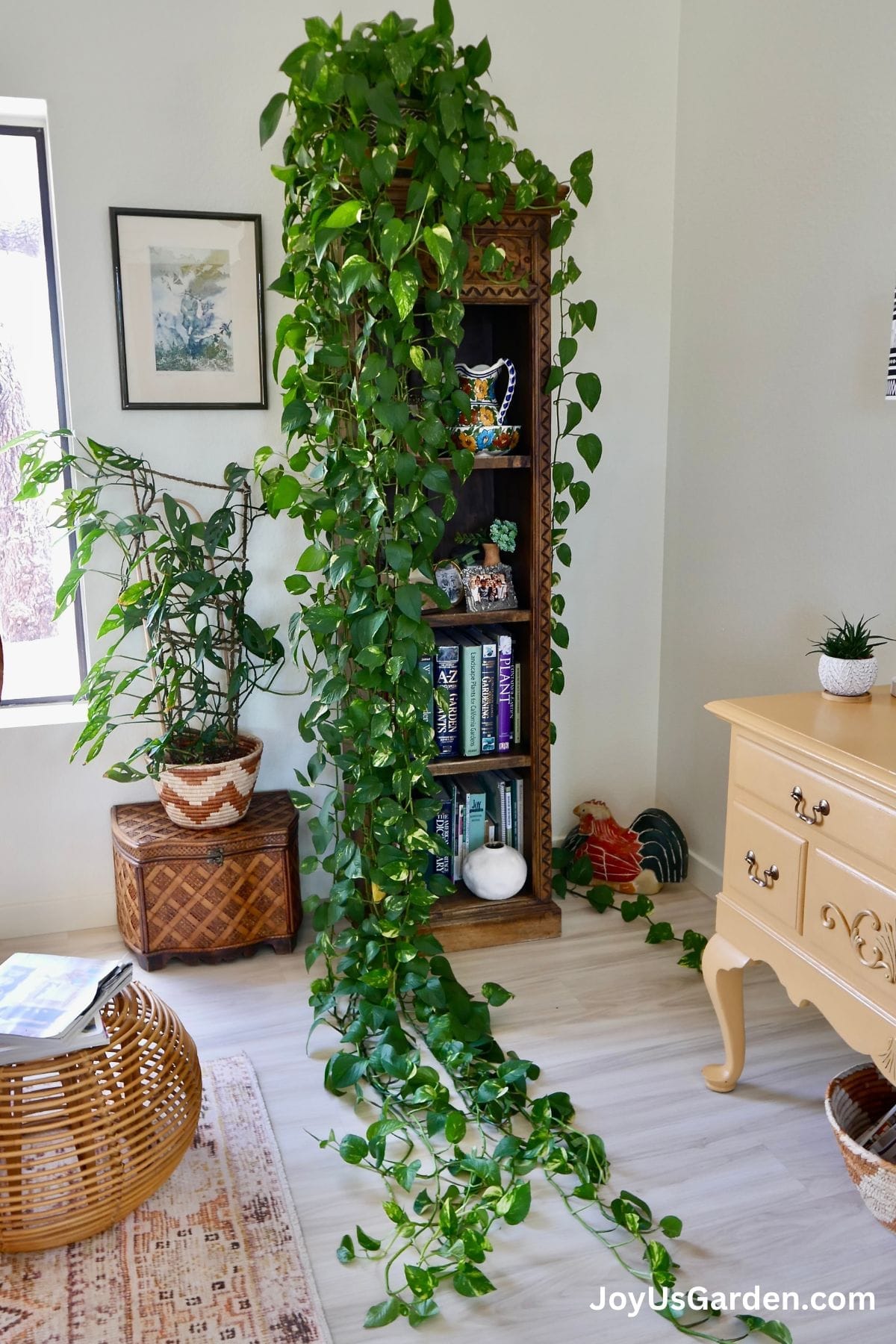
How Long Does A Pothos Grow?
In their native environments, they climb up trees and reach 60′. That’s why they’re considered invasive, hard to eliminate, and have earned another common name: Devil’s Ivy. Fortunately, we don’t have to worry about this in our homes!
I’ll tell you how long my Pothos are (which I tip prune once or twice a year): Golden Pothos – 11′ long (pictured above); Neon Pothos – 8′ long; Pothos NJoy – 2.5′ long.
Pothos Varieties
So many! These are the ones that I’ve seen: Golden Pothos, Marble Queen Pothos, Jade Pothos, Neon Pothos, Pothos NJoy, Glacier Pothos, Jessenia Pothos, Blue Pothos, Silver or Satin Pothos. The Silver Pothos is a different genus but is commonly grouped in with the Pothos of its common name.
Growers in different parts of the country, mainly in Florida, California, Texas, and Hawaii, grow different Pothos plants, so you may be unable to find all these. Golden Pothos, Marble Queen Pothos, and Jade Pothos (this one is solid green) are the ones I’ve seen most often. All have heart-shaped leaves.
Note: This post on Pothos plant care applies to all the varieties. Just know that some will do better in more light. More on that under “Exposure”.
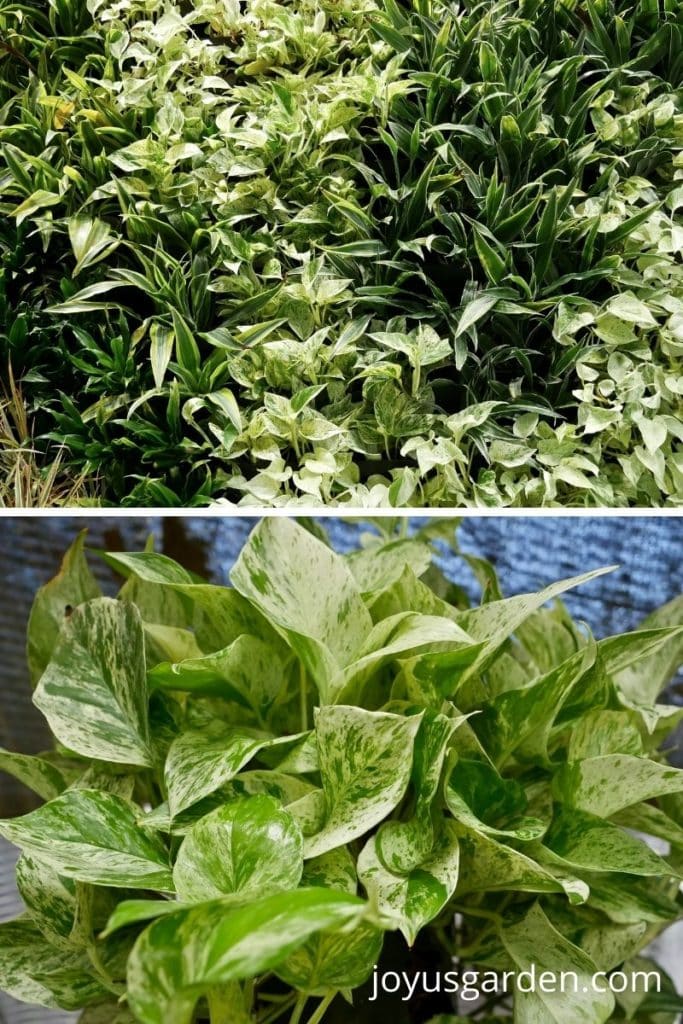
Pothos Plant Care And Growing Guide
Pothos Light Requirements
Low+ to high. Moderate light (bright indirect light) is the sweet spot for growing a Pothos plant.
They’ll tolerate low-light conditions but won’t grow much at all. Just remember, low light isn’t no light. A Golden Pothos (and the other variegated types) will lose variegation and revert to solid green in low light conditions.
That makes the Jade Pothos (the variety with solid green leaves) best for lower light. The leaves of any Pothos plant get smaller if not in bright light.
Neon Pothos (my favorite because of its vibrant chartreuse color) does best in medium to high light. Just keep any Pothos out of hot, sunny windows. They’ll burn in no time, especially if up against hot glass.
High light is fine for a Pothos, but make sure it’s at least 8-10′ away from a west or south-facing window. Indirect sunlight is fine.
If your Pothos only gets light from one side, you’ll want to rotate it occasionally. Those leaves will lean towards the light source.
In the winter months, water Pothos less often, holding off on fertilizing and pruning and possibly moving it to a spot with more light. More on winter houseplant care here.
I’ve done a post & video answering your FAQs About Pothos Plants that you’ll find helpful.

Pothos Watering
I thoroughly water my Pothos plants when the soil goes almost dry.
Here in the desert (I live in warm, sunny Tucson, AZ), that’s once every 6-7 days in the warmer months. It’s less often in the winter, maybe every 9-14 days. Your watering schedule will vary depending on your home’s environment, type of soil mix, and pot size.
Pothos are subject to root rot, so keeping them on the dry side rather than too wet is better. In the colder months, water less often.
Having drainage holes on the bottom of the pot so the excess water can freely flow out is necessary. Be sure not to let too much water build up in the saucer (if you have one underneath the pot).
I’ve done a guide to watering indoor plants that you might want to check out.

Temperature
This isn’t a big deal when it comes to Pothos care. They tolerate a wide range of temps. If your house is comfortable, it’ll also be so for your Pothos.
Just keep them away from cold drafts and heating or air conditioning vents.
Humidity
Pothos are tropical plants and grow in regions with high humidity. Despite this, they tolerate the lower humidity levels in our homes just fine. If you see occasional brown leaf tips, that most likely is a reaction to dry air.
Pothos Fertilizing
Spring and summer are the best times to fertilize your plants. Early fall is fine, too, if you’re in a temperate climate.
We have a long growing season here in Tucson from mid-February through October. I fertilize with Maxsea or Sea Grow, Grow Big, and Liquid Kelp seven times during the growing season. It’s how I feed all my tropical plants. I alternate using these granular and liquid fertilizers and don’t mix them.
Pothos aren’t fussy or needy; fertilizing too often will do more harm than good. Depending on your climate and growing zone, feeding two or three times a year may do it for your indoor plants.
Whatever houseplant food you choose, don’t use more than the recommended amount because salts build up and can burn the plant’s roots. Combined with fertilizing too often, this will show up as brown spots on the leaves.
You want to avoid fertilizing any stressed houseplant, i.e., bone dry or soaking wet. I don’t fertilize houseplants in late fall and winter because it’s not their active growing season.

Soil For Pothos
Pothos aren’t fussy at all when it comes to the mix they’re planted in. I always use good quality potting soil, which is peat-based, well-nourished, and drains well.
Potting soil doesn’t contain soil. Garden soil is way too heavy for houseplants. Make sure whatever mix you buy says it’s formulated for houseplants on the label.
These are the potting soils I alternate between using: Ocean Forest and Happy Frog. I also add in a few amendments when planting. You can read more about the soil blend I use in the link on repotting below.
Repotting/Transplanting
It’s not hard to do! Spring and summer are the best times to repot your Pothos. Early fall is fine if you’re in a warmer climate like me.
I usually go up a size – for example, from a 4″ to 6″ pot. If your 6″ Pothos is large and extremely pot-bound, you can jump to a 10″ pot.
If your Pothos has long trails, you might have to gently tie them up to keep them out of the way while repotting. Otherwise, they get in the way and/or turn into a tangled mess.
The type of pot doesn’t matter. I’ve grown them in plastic pots and directly planted in terra cotta. Fiberglass, resin, or ceramic would be just fine too.
It’s best if your pot has at least one drainage hole on the bottom so the excess water doesn’t build up. Generally, I repot my Pothos every five years so they have fresh soil. If you see the roots growing out of the bottom, then it’s time to repot.
I repotted 1 of my Pothos a few years ago. This post on Pothos Repotting details the process and soil mix used.
Pothos Pruning
These plants grow fast, so pruning is essential to pothos plant care.
You can prune your pothos to control the length by cutting straight across the stem just below a node. Doing this also stimulates new growth at the top. Pinching or pruning off the tips of the trails (1-2 nodes back) will do the same. I’ve done both to my Golden Pothos, and it’s kept a lot of fullness on top.
I’ve seen Pothos stems with some growth at the top, no growth in the middle, and a bit at the ends. Cut those ends (along with the bare middle), propagate them, and plant them back in the pot. This will rejuvenate your plant.
Like fertilizing and repotting, pruning is best done in spring and summer.
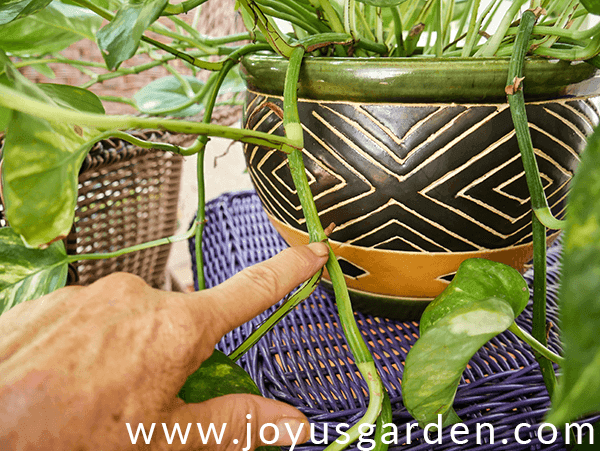
Propagating Pothos
Propagating a Pothos is so easy. I always propagate mine in water with great success. Aerial roots form off the nodes of the stems, so they’re already on their way to rooting for you.
Remove enough leaves off the stems (usually 1-4, depending on how long your cuttings are) to get them in water. It’s best to keep the leaves out of the water. Fill your glass or jar with enough water to cover one to three nodes.
Keep the water at this level and change it out as needed. More roots will appear in no time, usually seven to ten days.
The longest I’ve kept my Pothos stem cuttings in water was eight months, and they looked fine. I’ve heard they can grow in water for a long time.
This post and video on Pothos Propagation will give you more details on propagating and pruning.

Pests
When I lived in Santa Barbara, my Pothos got mealybugs. I spotted them early on and took action.
On commercial accounts, I saw Pothos infested with spider mites and scale. I’ve done posts on mealybugs, spider mites, and scale so you can identify and treat these pests to eliminate them.
Pests can travel from houseplant to houseplant fast and multiply like crazy, so make sure you get them under control as soon as you see them.
Yellow Leaves On Pothos Plants
An occasional yellow leaf is a natural occurrence for any plant. However, an excessive amount of yellow leaves is a sign that the plant isn’t happy.
The cause could be overwatering, underwatering, too much fertilizer, too much light or not enough light, and/or poor soil drainage. You can remove any yellow leaves to keep the plant looking good.
Toxic To Cats & Dogs
Pothos are considered to be toxic to pets. I consult the ASPCA website for my info on this subject and see in what way the plant is toxic. Here’s more info on this for you. If your pets are prone to chewing on plants, I recommend placing your Pothos up high or hanging it, making it difficult for them to reach.
Pothos Plant Care Video Guide
Common Mistakes In Pothos Plant Care
These plants are subject to root rot, so watering pothos too often will be their downfall.
Limp leaves can mean too little water.
Yellow leaves on a Pothos can mean too much water (the leaves usually brown a bit towards the center 1st), too dry, too wet, too much sun, or too much fertilizer.
Tiny brown tips on the ends of the leaves are just a reaction to the dry air in our homes.
If pothos aren’t getting enough light, the leaves will become smaller and lose their color and variegation.
Growing them in a dark corner or a room with no light. Pothos are often billed as low-light plants but do best in bright, indirect natural light.
I once had a viewer ask this, so I want to include it: “Can you make the spacing of the leaves on pothos stems closer?” The answer is no. If your pothos lose leaves up and down the stems, new ones won’t appear where the old ones were. The smaller leafed varieties (like NJoy, which you see in the lead photo) grow quite tight, with the leaves closer together on the stems.
Note: This guide was first published on July 10, 2018. It was updated with more info on August 18, 2021 & August 30, 2023.
In conclusion, I know there’s a lot of info here, but this is one of the easiest plants to maintain and has been very long-lived for me. The two best things you can do to grow a pothos plant are to give it bright, natural light and not to overwater. These lush and versatile plants are keepers!
Happy gardening,




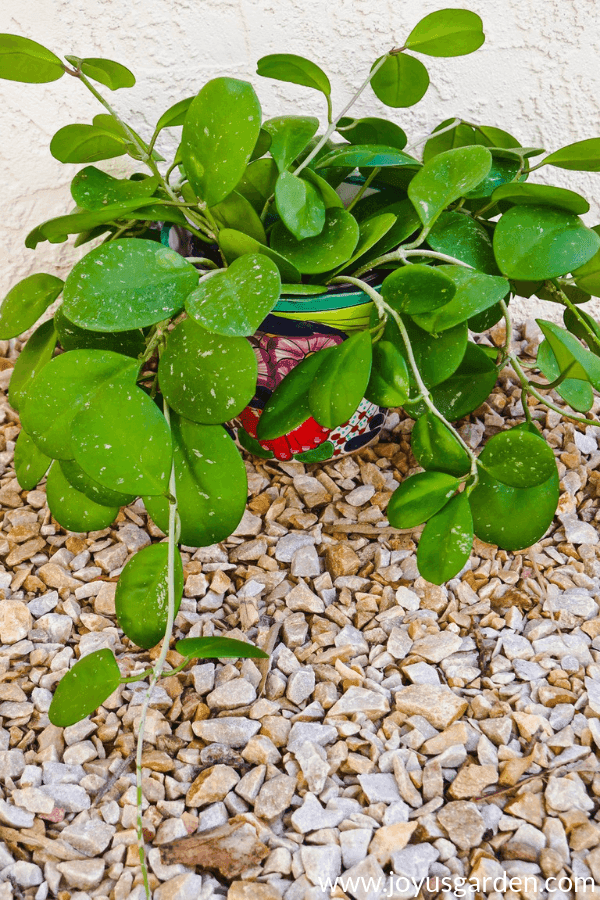


Hi Nell!
Thanks for sharing this awesome post, very informative:)
Have a great day!
So glad I found your site. Gained a great deal of information.
Thanks
I’m glad you found it too Patricia! Nell
Hey! I was hoping you could advise – I repotted a while back and the soil mixture wasn’t right – it’s causing my pothos to stress out. I don’t want to repot as it’s getting cold – is it a good idea to take it out of it’s soil and put it into water instead? I have had massive success propogating her in the past.
Michelle – Pothos root readily in water so go right ahead. I’ve never grown 1 for the long haul in water – only 6 months. Nell